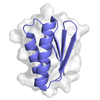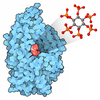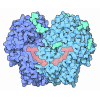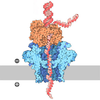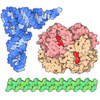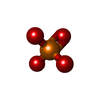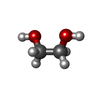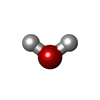[English] 日本語
 Yorodumi
Yorodumi- PDB-3tc9: Crystal structure of an auxiliary nutrient binding protein (BT_34... -
+ Open data
Open data
- Basic information
Basic information
| Entry | Database: PDB / ID: 3tc9 | ||||||
|---|---|---|---|---|---|---|---|
| Title | Crystal structure of an auxiliary nutrient binding protein (BT_3476) from Bacteroides thetaiotaomicron VPI-5482 at 2.23 A resolution | ||||||
 Components Components | Hypothetical hydrolase | ||||||
 Keywords Keywords | HYDROLASE / 6-bladed beta-propeller / Immunoglobulin-like / Structural Genomics / Joint Center for Structural Genomics / JCSG / Protein Structure Initiative / PSI-BIOLOGY | ||||||
| Function / homology |  Function and homology information Function and homology informationTolB, C-terminal domain / IPT/TIG domain / IPT domain / Six-bladed beta-propeller, TolB-like / 6 Propeller / Neuraminidase / Prokaryotic membrane lipoprotein lipid attachment site profile. / Immunoglobulin E-set / Immunoglobulin-like fold / Immunoglobulins ...TolB, C-terminal domain / IPT/TIG domain / IPT domain / Six-bladed beta-propeller, TolB-like / 6 Propeller / Neuraminidase / Prokaryotic membrane lipoprotein lipid attachment site profile. / Immunoglobulin E-set / Immunoglobulin-like fold / Immunoglobulins / Immunoglobulin-like / Sandwich / Mainly Beta Similarity search - Domain/homology | ||||||
| Biological species |  Bacteroides thetaiotaomicron (bacteria) Bacteroides thetaiotaomicron (bacteria) | ||||||
| Method |  X-RAY DIFFRACTION / X-RAY DIFFRACTION /  SYNCHROTRON / SYNCHROTRON /  MAD / Resolution: 2.23 Å MAD / Resolution: 2.23 Å | ||||||
 Authors Authors | Joint Center for Structural Genomics (JCSG) | ||||||
 Citation Citation |  Journal: To be published Journal: To be publishedTitle: Crystal structure of a Hypothetical hydrolase (BT_3476) from Bacteroides thetaiotaomicron VPI-5482 at 2.23 A resolution Authors: Joint Center for Structural Genomics (JCSG) | ||||||
| History |
|
- Structure visualization
Structure visualization
| Structure viewer | Molecule:  Molmil Molmil Jmol/JSmol Jmol/JSmol |
|---|
- Downloads & links
Downloads & links
- Download
Download
| PDBx/mmCIF format |  3tc9.cif.gz 3tc9.cif.gz | 353.4 KB | Display |  PDBx/mmCIF format PDBx/mmCIF format |
|---|---|---|---|---|
| PDB format |  pdb3tc9.ent.gz pdb3tc9.ent.gz | 288.1 KB | Display |  PDB format PDB format |
| PDBx/mmJSON format |  3tc9.json.gz 3tc9.json.gz | Tree view |  PDBx/mmJSON format PDBx/mmJSON format | |
| Others |  Other downloads Other downloads |
-Validation report
| Summary document |  3tc9_validation.pdf.gz 3tc9_validation.pdf.gz | 461.4 KB | Display |  wwPDB validaton report wwPDB validaton report |
|---|---|---|---|---|
| Full document |  3tc9_full_validation.pdf.gz 3tc9_full_validation.pdf.gz | 465.7 KB | Display | |
| Data in XML |  3tc9_validation.xml.gz 3tc9_validation.xml.gz | 34.4 KB | Display | |
| Data in CIF |  3tc9_validation.cif.gz 3tc9_validation.cif.gz | 50.1 KB | Display | |
| Arichive directory |  https://data.pdbj.org/pub/pdb/validation_reports/tc/3tc9 https://data.pdbj.org/pub/pdb/validation_reports/tc/3tc9 ftp://data.pdbj.org/pub/pdb/validation_reports/tc/3tc9 ftp://data.pdbj.org/pub/pdb/validation_reports/tc/3tc9 | HTTPS FTP |
-Related structure data
| Similar structure data | |
|---|---|
| Other databases |
- Links
Links
- Assembly
Assembly
| Deposited unit | 
| ||||||||
|---|---|---|---|---|---|---|---|---|---|
| 1 |
| ||||||||
| 2 | 
| ||||||||
| 3 | 
| ||||||||
| Unit cell |
|
- Components
Components
| #1: Protein | Mass: 48990.422 Da / Num. of mol.: 2 / Fragment: UNP residues 29-457 Source method: isolated from a genetically manipulated source Source: (gene. exp.)  Bacteroides thetaiotaomicron (bacteria) Bacteroides thetaiotaomicron (bacteria)Gene: BT_3476 / Plasmid: SpeedET / Production host:  #2: Chemical | #3: Chemical | ChemComp-EDO / #4: Chemical | #5: Water | ChemComp-HOH / | Has protein modification | Y | Sequence details | THE CONSTRUCT WAS EXPRESSED WITH A PURIFICATION TAG MGSDKIHHHHHHENLYFQG. THE TAG WAS REMOVED WITH ...THE CONSTRUCT WAS EXPRESSED WITH A PURIFICATI | |
|---|
-Experimental details
-Experiment
| Experiment | Method:  X-RAY DIFFRACTION / Number of used crystals: 1 X-RAY DIFFRACTION / Number of used crystals: 1 |
|---|
- Sample preparation
Sample preparation
| Crystal | Density Matthews: 2.38 Å3/Da / Density % sol: 48.25 % |
|---|---|
| Crystal grow | Temperature: 277 K / Method: vapor diffusion, sitting drop Details: 20.00% polyethylene glycol 3350, 0.20M sodium dihydrogen phosphate, NANODROP, VAPOR DIFFUSION, SITTING DROP, temperature 277K |
-Data collection
| Diffraction | Mean temperature: 100 K | |||||||||||||||||||||||||||||||||||||||||||||||||||||||||||||||||||||||||||||
|---|---|---|---|---|---|---|---|---|---|---|---|---|---|---|---|---|---|---|---|---|---|---|---|---|---|---|---|---|---|---|---|---|---|---|---|---|---|---|---|---|---|---|---|---|---|---|---|---|---|---|---|---|---|---|---|---|---|---|---|---|---|---|---|---|---|---|---|---|---|---|---|---|---|---|---|---|---|---|
| Diffraction source | Source:  SYNCHROTRON / Site: SYNCHROTRON / Site:  SSRL SSRL  / Beamline: BL9-2 / Wavelength: 0.91837,0.97932,0.97913 / Beamline: BL9-2 / Wavelength: 0.91837,0.97932,0.97913 | |||||||||||||||||||||||||||||||||||||||||||||||||||||||||||||||||||||||||||||
| Detector | Type: MARMOSAIC 325 mm CCD / Detector: CCD / Date: Jun 22, 2011 / Details: double crystal monochromator | |||||||||||||||||||||||||||||||||||||||||||||||||||||||||||||||||||||||||||||
| Radiation | Monochromator: double crystal / Protocol: MAD / Monochromatic (M) / Laue (L): M / Scattering type: x-ray | |||||||||||||||||||||||||||||||||||||||||||||||||||||||||||||||||||||||||||||
| Radiation wavelength |
| |||||||||||||||||||||||||||||||||||||||||||||||||||||||||||||||||||||||||||||
| Reflection | Resolution: 2.23→29.899 Å / Num. obs: 45197 / % possible obs: 97.7 % / Observed criterion σ(I): -3 / Biso Wilson estimate: 42.202 Å2 / Rmerge(I) obs: 0.065 / Net I/σ(I): 8.31 | |||||||||||||||||||||||||||||||||||||||||||||||||||||||||||||||||||||||||||||
| Reflection shell |
|
-Phasing
| Phasing | Method:  MAD MAD |
|---|
- Processing
Processing
| Software |
| ||||||||||||||||||||||||||||||||||||||||||||||||||||||||||||||||||||||||||||||||||||||||||||||||||||||||||||
|---|---|---|---|---|---|---|---|---|---|---|---|---|---|---|---|---|---|---|---|---|---|---|---|---|---|---|---|---|---|---|---|---|---|---|---|---|---|---|---|---|---|---|---|---|---|---|---|---|---|---|---|---|---|---|---|---|---|---|---|---|---|---|---|---|---|---|---|---|---|---|---|---|---|---|---|---|---|---|---|---|---|---|---|---|---|---|---|---|---|---|---|---|---|---|---|---|---|---|---|---|---|---|---|---|---|---|---|---|---|
| Refinement | Method to determine structure:  MAD / Resolution: 2.23→29.899 Å / Cor.coef. Fo:Fc: 0.961 / Cor.coef. Fo:Fc free: 0.9374 / Occupancy max: 1 / Occupancy min: 0.25 / Cross valid method: THROUGHOUT / σ(F): 0 MAD / Resolution: 2.23→29.899 Å / Cor.coef. Fo:Fc: 0.961 / Cor.coef. Fo:Fc free: 0.9374 / Occupancy max: 1 / Occupancy min: 0.25 / Cross valid method: THROUGHOUT / σ(F): 0 Details: 1. HYDROGENS HAVE BEEN ADDED IN THE RIDING POSITIONS 2. ATOM RECORD CONTAINS SUM OF TLS AND RESIDUAL B FACTORS. ANISOU RECORD CONTAINS SUM OF TLS AND RESIDUAL U FACTORS. 3. A MET-INHIBITION ...Details: 1. HYDROGENS HAVE BEEN ADDED IN THE RIDING POSITIONS 2. ATOM RECORD CONTAINS SUM OF TLS AND RESIDUAL B FACTORS. ANISOU RECORD CONTAINS SUM OF TLS AND RESIDUAL U FACTORS. 3. A MET-INHIBITION PROTOCOL WAS USED FOR SELENOMETHIONINE INCORPORATION DURING PROTEIN EXPRESSION. THE OCCUPANCY OF THE SE ATOMS IN THE MSE RESIDUES WAS REDUCED TO 0.75 TO ACCOUNT FOR THE REDUCED SCATTERING POWER DUE TO PARTIAL S-MET INCORPORATION. 4. 1,2 ETHANEDIOL (EDO) AND PHOSPATE (PO4) FROM THE CRYSTALLIZATION CONDITIONS AND CHLORIDE (CL)FROM THE EXPRESSION OR PURIFICATION BUFFERS HAVE BEEN MODELED IN THE SOLVENT STRUCTURE. 5. NCS RESTRAINTS WERE APPLIED USING BUSTER'S LSSR RESTRAINT REPRESENTATION (-AUTONCS). 6. THE REFINEMENT WAS RESTRAINED AGAINST THE MAD PHASES.
| ||||||||||||||||||||||||||||||||||||||||||||||||||||||||||||||||||||||||||||||||||||||||||||||||||||||||||||
| Displacement parameters | Biso max: 117.08 Å2 / Biso mean: 43.4784 Å2 / Biso min: 9.45 Å2
| ||||||||||||||||||||||||||||||||||||||||||||||||||||||||||||||||||||||||||||||||||||||||||||||||||||||||||||
| Refinement step | Cycle: LAST / Resolution: 2.23→29.899 Å
| ||||||||||||||||||||||||||||||||||||||||||||||||||||||||||||||||||||||||||||||||||||||||||||||||||||||||||||
| Refine LS restraints |
| ||||||||||||||||||||||||||||||||||||||||||||||||||||||||||||||||||||||||||||||||||||||||||||||||||||||||||||
| LS refinement shell | Resolution: 2.23→2.29 Å / Total num. of bins used: 20
| ||||||||||||||||||||||||||||||||||||||||||||||||||||||||||||||||||||||||||||||||||||||||||||||||||||||||||||
| Refinement TLS params. | Method: refined / Refine-ID: X-RAY DIFFRACTION
| ||||||||||||||||||||||||||||||||||||||||||||||||||||||||||||||||||||||||||||||||||||||||||||||||||||||||||||
| Refinement TLS group |
|
 Movie
Movie Controller
Controller


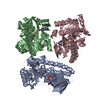


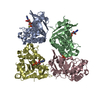
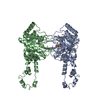

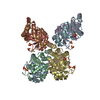

 PDBj
PDBj
